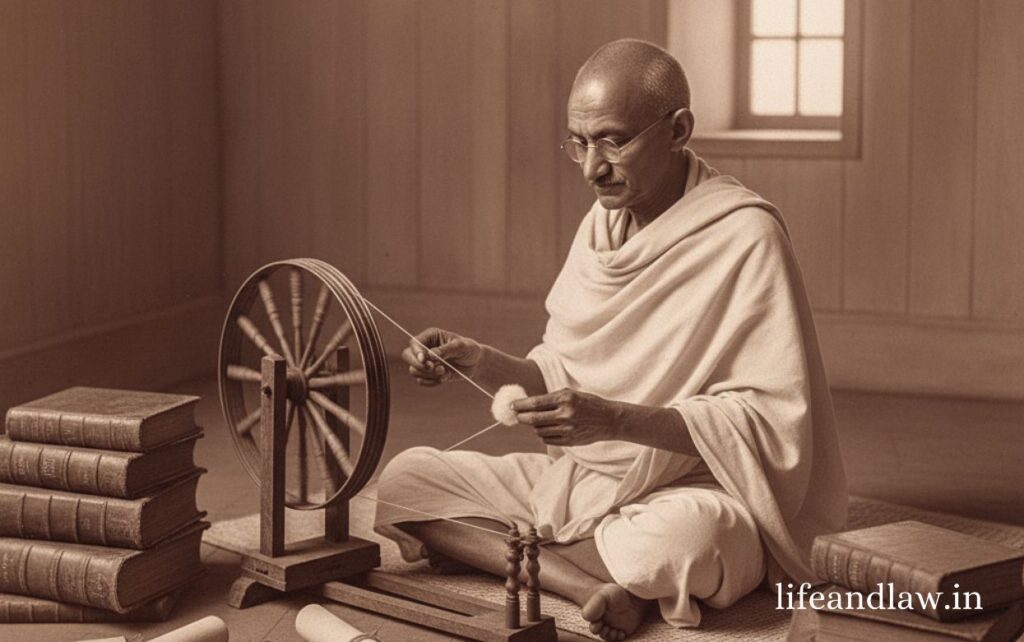Trending

Every year on October 2nd, the globe remembers Gandhi Jayanti, which honours the birth of Mahatma Gandhi, while also observing the International Day of Non-Violence, which is recognised as a symbol of peaceful resistance. These observances are more than just symbolic; they provide a chance to consider Gandhi’s lasting ideology of non-violent resistance and its critical connection with legal frameworks around the world.
Gandhi’s lessons are not only relevant, but also important, as nations around the world grapple with injustice, inequality, and authoritarian tendencies. His non-violent resistance strategy, Satyagraha, was a disciplined, moral engagement with the law rather than an act of revolt amid chaos. This article investigates how Gandhi’s beliefs influenced our understanding of legal protest and what lessons they have for today.
Non-violent resistance does not involve passivity or submission. Rather, it is an active kind of protest that attempts to effect change without using violence or aggressiveness. It covers measures like peaceful marches, civil disobedience, non-cooperation, hunger strikes, among others.
Gandhi refined this into Satyagraha, which translates as “truth-force” or “soul-force.” It emphasised that truth and morality must govern political actions, and that people battling injustice should use discipline, courage, and nonviolence. Non-violent resistance, as opposed to violent uprising, appeals to the conscience of the oppressor, the public, and legal institutions.
This constructive and moral underpinning makes non-violent resistance an effective instrument within legal and democratic institutions.
Before becoming the father of the Indian independence movement, Mahatma Gandhi was a professional lawyer who studied in England and practiced in both South Africa and India. His legal background shaped his perspective on the state, justice, and the citizen’s responsibility in resisting power.
Gandhi believed in the rule of law, but he also felt that unjust laws are inherently violent. He emphasised that when laws contradict moral values, citizens have both the right and the duty to resist—peacefully and politely.
He pioneered this in South Africa by opposing racial legislation through civil disobedience, refusing to carry registration passes, and embracing jail. In India, he used similar techniques during crucial movements:
The Champaran Satyagraha (1917) opposed forced indigo growing,
The Salt March (1930) against the colonial monopoly of salt
The Quit India Movement (1942) demanded an end to British rule.
On each occasion, Gandhi confronted the judicial system with moral authority, embracing the repercussions of civil disobedience rather than acting outside of it. This resulted in public pressure and judicial scrutiny, prompting institutions to re-examine unjust laws.
In modern democracies, Gandhi’s method has influenced a wide range of movements. The U.S. Civil Rights Movement, led by Martin Luther King Jr., followed Gandhi’s tactic of peaceful resistance. The anti-apartheid campaign in South Africa, led by Nelson Mandela, was similarly founded on nonviolence—at least in its early phases.
Legal systems nowadays frequently find themselves at a crossroads with non-violent protest. On the one hand, constitutions safeguard the right to peaceful assembly and free expression. On the other hand, governments may criminalise dissent in the interests of national security or public order.
Gandhi’s legacy encourages legal frameworks to view civil disobedience not as an act of defiance, but as a form of political participation. When done non-violently, opposition can cause legislative reform, judicial examination, and social introspection without destabilising the country.
Gandhi’s philosophy says that:
Laws must be based on fairness, not mere authority.
Citizens have a moral right to protest unjust laws, but only through nonviolent means.
Governments must allow for peaceful dissent because it reflects the health of a democracy.
The lesson for lawmakers is to hear the voices of non-violent protestors rather than silence them. Laws should be developed through debate, not coercion. Residents who come to the streets with slogans rather than stones show their trust in the judicial process to eventually provide justice.
Adv. Abdul Mulla, an author and legal practitioner, draws inspiration from Mahatma Gandhi’s ideology in his work for platforms such as www.asmlegalservices and www.lifeandlaw.in. Through his legal publications and campaigning, he emphasises the importance of pursuing justice within the confines of the law, reflecting Gandhi’s idea that meaningful change is founded on moral conviction and peaceful resistance.
On Gandhi Jayanti and the International Day of Nonviolence, Adv. Abdul Mulla reminds us that unjust laws are a kind of violence, and that challenging them ethically through legal means is both our right and responsibility.
Adv. Abdul Mulla (Mob. No. 937 007 2022) is a seasoned legal professional with over 18 years of experience in advocacy, specializing in diverse areas of law, including Real Estate and Property Law, Matrimonial and Divorce Matters, Litigation and Dispute Resolution, and Will and Succession Planning. read more….
Copyright BlazeThemes. 2025